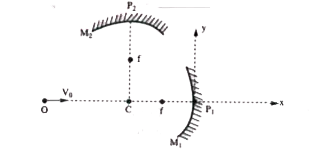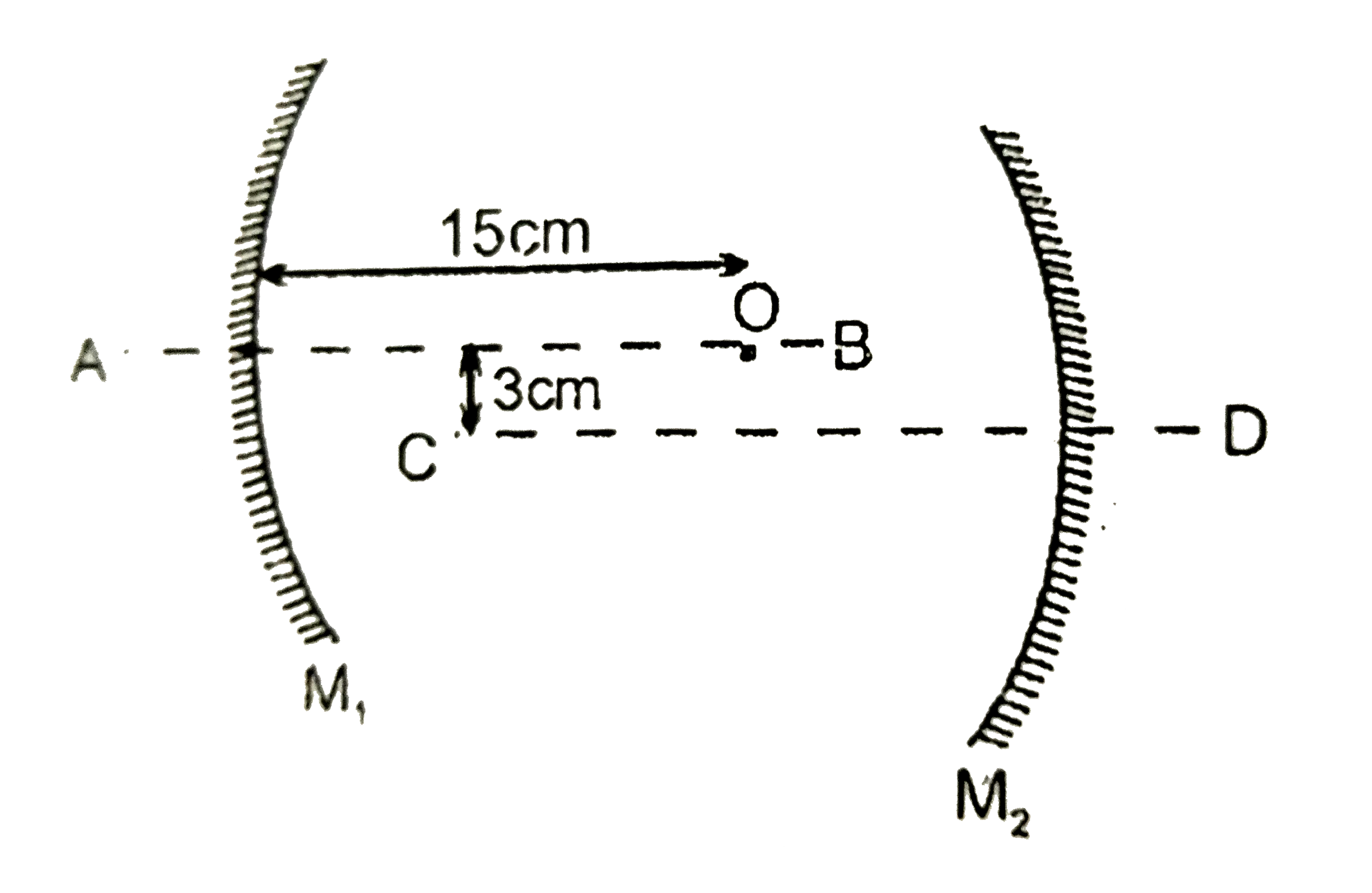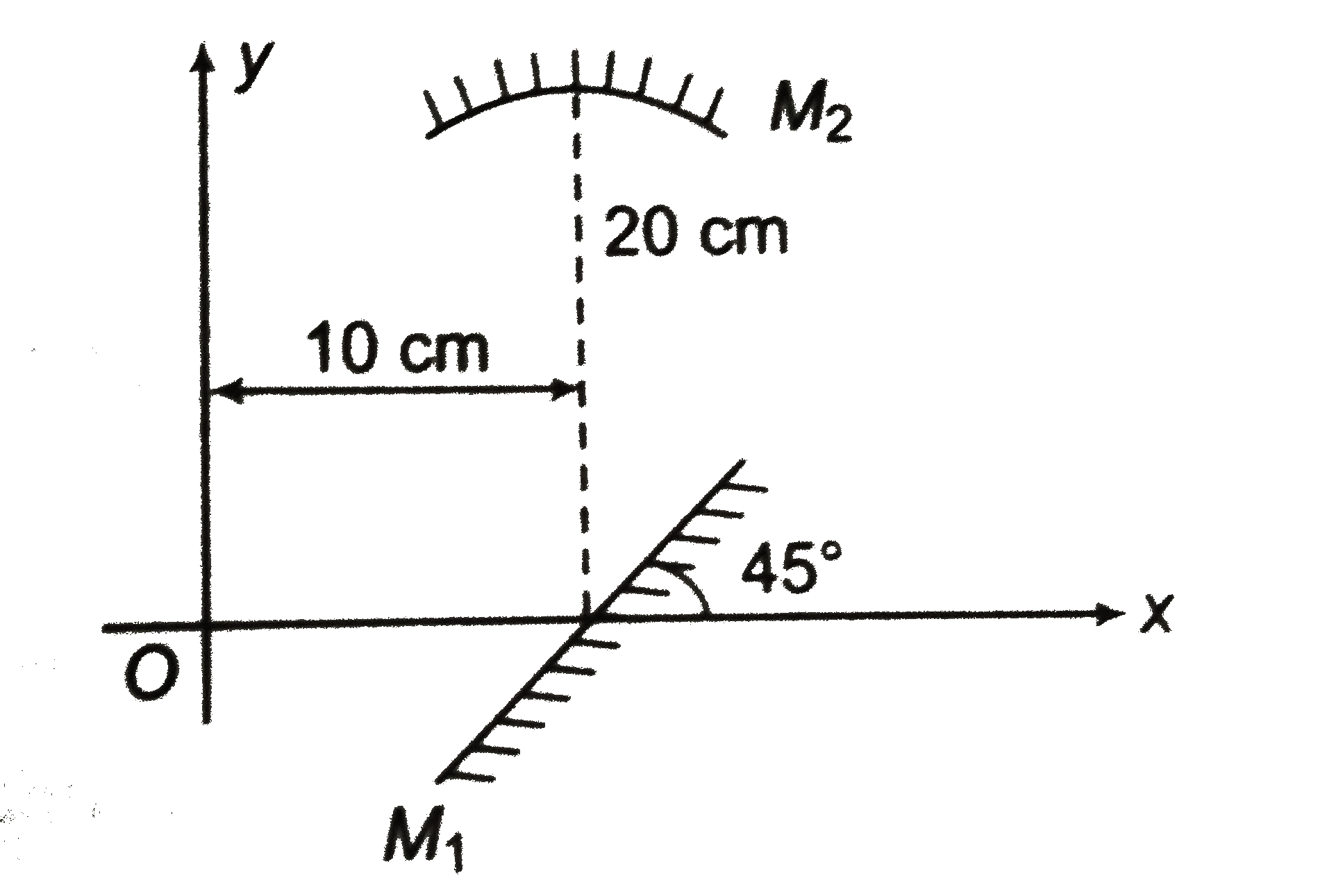Two identical concave mirrors M1 & M2 with principal axes perpendicular to each other and pole P1 of mirro M1 at origin is as shown. Let f be the focal length and C be the common centre of curvature for both mirrors. A point object O is at (−5f,0) and is moving with a velocity →C=v0ˆi m/s.

Consider rays incident on mirror M2 the co-ordinates of the final imasge formed is
at position (-x, 0) and moving along x -axis
at position (+x,0) and moving along x- axis
at position (-x, 0) and moving along y - axis
at position (+y,0) and moving along y - axis
The correct Answer is:A
Step by step video & image solution for Two identical concave mirrors M_(1) & M_(2) with principal axes perpendicular to each other and pole P_(1) of mirro M_(1) at origin is as shown. Let f be the focal length and C be the common centre of curvature for both mirrors. A point object O is at (-5f,0) and is moving with a velocity vecC=v_(0)hati m/s. Consider rays incident on mirror M_(2) the co-ordinates of the final imasge formed is by Physics experts to help you in doubts & scoring excellent marks in Class 12 exams.
Updated on:21/07/2023Topper's Solved these Questions
- GEOMETRICAL OPTICSBOOK - AAKASH SERIESCHAPTER - GEOMETRICAL OPTICSEXERCISE - PRACTICE SHEET (EXERICSE-II (LEVEL-II (ADVANCED) MATRIX MATCHING TYPE QUESTIONS))
1 Video
- GEOMETRICAL OPTICSBOOK - AAKASH SERIESCHAPTER - GEOMETRICAL OPTICSEXERCISE - PRACTICE SHEET (EXERICSE-II (LEVEL-II (ADVANCED) INTEGER TYPE QUESTIONS))
5 Videos
- GEOMETRICAL OPTICSBOOK - AAKASH SERIESCHAPTER - GEOMETRICAL OPTICSEXERCISE - PRACTICE SHEET (EXERICSE-II (LEVEL-II (ADVANCED) STRAIGHT OBJECTIVE TYPE QUESTIONS))
2 Videos
- ELEMENTS OF VECTORSBOOK - AAKASH SERIESCHAPTER - ELEMENTS OF VECTORSEXERCISE - QUESTIONS FOR DESCRIPTIVE ANSWERS
10 Videos
- LAWS OF MOTIONBOOK - AAKASH SERIESCHAPTER - LAWS OF MOTIONEXERCISE - PRACTICE EXERCISE
106 Videos
Similar Questions
What is the focal length of a concave mirror of radius of curvature 16.0 cm?
View SolutionTwo plane mirror M1andM2 are inclined to each other at 70∘. A ray incident on the mirror M1 at an angle θ fallls on M2 and is then reflected parallel to M1 for
View SolutionTwo masses, m1 and m2 , are moving with velocities v1 and v2. Find their total kinetic energy in the reference frame of centre of mass.
View SolutionA point object is moving with a speed v before an arrangement of two mirrors as shown in figure.

Find the velocity of image in mirror M1 with respect to image in mirror M2
View SolutionFor a concave mirror of focal length f, image is 2 times larger. Then the object distance from the mirror can be
View SolutionConsider two perpendicular mirrors M1 and M2 and a point object O. Taking origin at the point of intersection of the mirrros and the coordinates of object as (x,y), find the position and number of images.
View SolutionAn object is placed at a distance f in the front of a convex mirror. If focal length of the mirror is f, then distance of image from pole of the mirror is
View SolutionA ray of light is incident on a concave mirror . It is parallel to the principal axis and its height from principal axis is equal to the focal length of the mirror. The ratio of the distance of point B to the distance of the focus from the centre of curvature is (AB is the reflected ray)
_E01_055_Q01.png)
View SolutionIn the shown figure M1 and M2 are two concave mirrors of the same focal length 10cm . AB and CD are their pricipal axes respectively. A point object O is kept on the line AB at a distance 15cm from M1 . The distance between the mirror is 20cm . Considering two successive reflections first on M1 and then on M2 . The distance of final image from the line AB is:

View SolutionA plane mirror (M1) and a concave mirror (M2) of focal length 10 cm are arranged as shown in figure. An object is kept at origin. Answers the following questions. (consider image formed by single reflection in all cases).

The coordination of image formed by concave mirror are
View Solution